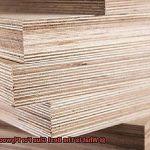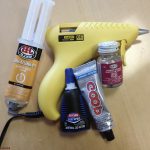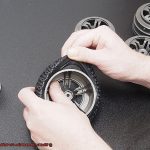Picture this: a moment in time, captured piece by piece in a mesmerizing puzzle. The thrill of putting it all together is addictive, but what happens when you want to frame and showcase your masterpiece? No need to worry. In this blog post, we’ll unveil the best glue for puzzles to frame, ensuring your beloved creation remains intact for years to come.
Hook:
Whether you’re a devoted puzzle enthusiast or just enjoy solving them casually, turning your finished puzzle into stunning wall art is the ultimate goal. But choosing the right adhesive can leave you feeling puzzled once again. Fear not – we’re here to ease your frustrations and guide you through this sticky situation with confidence.
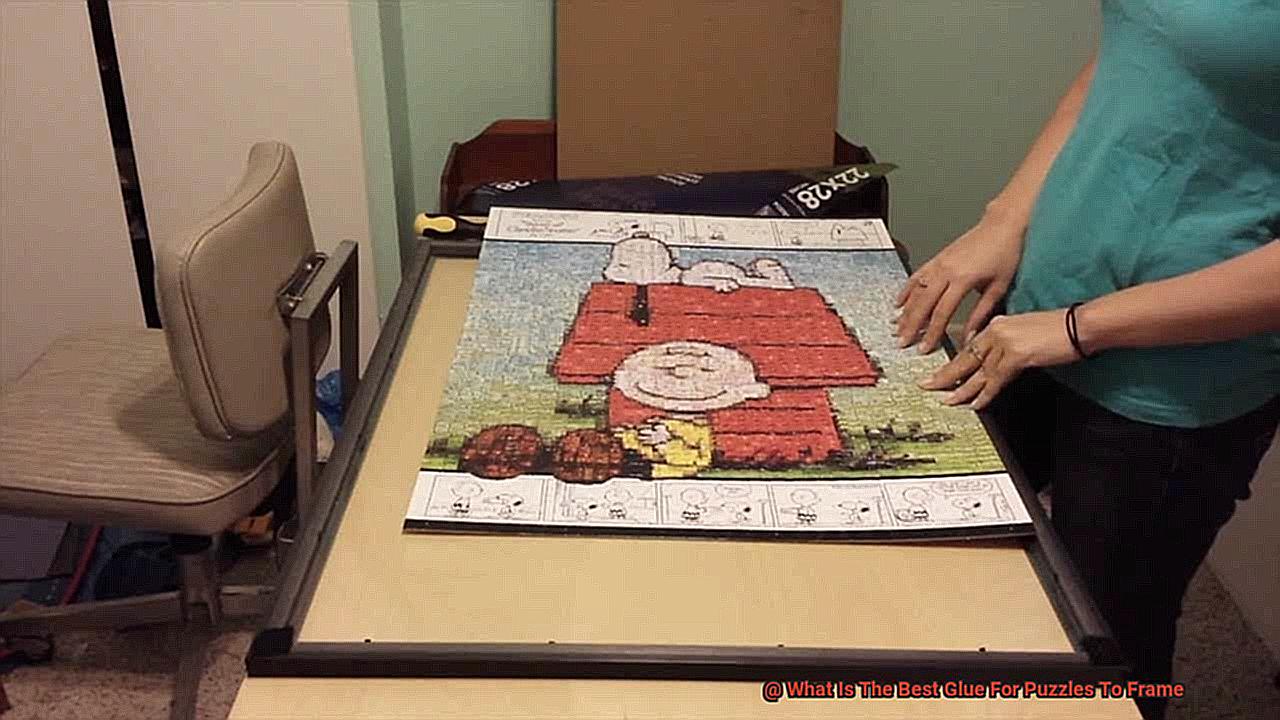
Key Points:
- Preserving Puzzle Perfection: Dive into various adhesive options as we explore how each glue affects the longevity and quality of your masterpiece. From liquid glues to adhesive sheets, we leave no stone unturned in our quest for the perfect preservation solution.
- Easy Application for All: We understand that not everyone has crafty fingers or infinite patience. That’s why we assess the simplicity and user-friendliness of each glue option, ensuring a stress-free framing experience for everyone involved.
- Unyielding Durability: Frames are meant to protect and showcase your puzzle, so it’s crucial to choose a glue that can withstand environmental factors like humidity and temperature changes. We compare different glues based on their ability to keep your puzzle intact over time, guarding against warping or fading.
- Clear and Flawless Finish: Your showpiece deserves to shine without any unsightly glue stains or residue stealing the spotlight. We evaluate each glue’s transparency and its ability to create a smooth, seamless finish that lets your puzzle take center stage – no visible signs of adhesive allowed.
Your finished puzzle is more than just a fleeting moment of joy; it deserves a lifetime of display. By discovering the best glue for puzzles to frame, we empower you to transform your hard work into a captivating piece of art that can be treasured for generations. Join us on this exciting adhesive adventure and let’s frame those masterpieces with unwavering confidence.
Types of Glue for Puzzles
Contents
- 1 Types of Glue for Puzzles
- 2 Factors to Consider When Choosing the Best Glue for Puzzles to Frame
- 3 Pros and Cons of Puzzle Glues
- 4 Pros and Cons of Craft Glues/Clear Drying Adhesives
- 5 Pros and Cons of Epoxy Resin/Super Glues
- 6 Tips for Applying Glue to Puzzles and Frames
- 7 How to Test a Small Amount of Glue on a Spare Piece Before Gluing Entire Puzzle?
- 8 Conclusion
When it comes to framing puzzles, the right glue can make all the difference. You need a glue that will securely hold your puzzle pieces together and create a strong bond when attaching the puzzle to a frame. In this article, we will explore different types of glue that can be used for framing puzzles and discuss their unique advantages and disadvantages. So, let’s dive in and discover the perfect glue for your puzzle framing project.
Puzzle Glue
Completing a jigsaw puzzle is an impressive feat, but preserving and showcasing your masterpiece requires the perfect puzzle glue. Puzzle glue, like the magical finishing touch, ensures a secure bond that withstands the test of time, protecting your artwork’s original beauty. Let’s dive into the captivating world of puzzle glue and explore the various types and their unique advantages and disadvantages.
First in line is the captivating liquid puzzle glue. This adhesive, applied with precision using a brush or sponge, dries clear and glossy, enveloping your puzzle in a protective coating. Puzzle enthusiasts adore the smooth finish achieved with liquid glue, as it maintains the puzzle’s original state. However, this process demands a bit of extra time and attention to detail, ensuring each piece is perfectly coated.
Next on our list is the enticing spray puzzle glue. If convenience and effortless application are of paramount importance to you, this glue will be your trusted companion. With a simple spray, you can achieve even coverage across the entire surface of your puzzle. Like liquid glue, it dries clear and glossy, imparting a protective finish. The spray-on method saves you time and effort without compromising on quality. Just remember to create a well-ventilated environment before embarking on your spraying adventure.
Last but certainly not least are the enchanting peel-and-stick adhesive sheets. These pre-cut sheets, tailored to fit standard puzzle sizes, offer an incredibly user-friendly experience. Peel off the backing and press the sticky side onto the back of your completed puzzle – it’s as easy as that. This adhesive provides a strong bond without the need for brushes or sprays. The peel-and-stick sheets are perfect for those seeking a hassle-free solution, allowing you to swiftly secure your puzzles for display or framing.
Now, when it comes to selecting the ideal puzzle glue for your needs, personal preference and desired outcomes play a significant role. If you value a smooth finish and don’t mind investing a bit more time in the application process, liquid glue will be your faithful companion. Conversely, if convenience and time-saving are your top priorities, spray glue or peel-and-stick adhesive sheets will be your trusted allies.
Craft Glue/Clear Drying Adhesive
Preserving and showcasing your completed jigsaw puzzle is like capturing a moment of pure magic. And just like a skilled magician needs the perfect trick, finding the right puzzle glue is essential for protecting your masterpiece for years to come. Today, let’s dive into the enchanting world of craft glue, also known as clear drying adhesive, and discover its advantages and disadvantages when it comes to framing your puzzle.
Advantages:
- Ease of Use: Craft glue comes in a convenient squeeze bottle, offering precise application that eliminates messy mishaps. With this magical adhesive, you have full control over the amount of glue you apply, ensuring an even coat on the backside of your puzzle.
- Aesthetics: Craft glue works its invisible wonders as it dries transparently. This makes it the ideal choice for preserving the captivating beauty of your finished puzzle. With no visible traces of glue, every intricate detail and vibrant color remains intact, creating a mesmerizing display.
- Safety First: Craft glue is a magical potion that is non-toxic and safe to use for both young and old puzzle enthusiasts. Whether you’re embarking on a puzzling adventure with your little ones or indulging in some solo puzzling time, you can rest assured that craft glue won’t cast any harmful spells on anyone’s health.
- Strong Bond and Durability: Once dry, craft glue weaves its spell by creating a firm connection between puzzle pieces. This ensures that your masterpiece stays perfectly intact, even if you decide to hang it on a wall or display it in a bustling area. The relentless grip of this adhesive prevents any shifting or coming apart over time.
- Flexibility: Craft glue possesses a touch of magic that allows your puzzle to endure minor movements without compromising its structural integrity. So if life accidentally bumps into your framed puzzle while cleaning or redecorating, there’s no need to conjure up panic – it can withstand the magic of everyday life.
Epoxy Resin/Super Glue
In our quest for the perfect adhesive to frame your completed jigsaw masterpieces, we’ve explored the wonders of craft glue. Today, we turn our attention to two formidable contenders: epoxy resin and super glue. As a seasoned expert in puzzle framing, I am thrilled to guide you through the advantages and disadvantages of these adhesive powerhouses. Prepare for a thrilling journey into the world of framing puzzles with epoxy resin and super glue.
Advantages of Epoxy Resin:
- Seamless Finish: Irregular shapes and uneven edges won’t stand a chance against the magical powers of epoxy resin. This two-part adhesive is a master at filling gaps, leaving no trace of imperfection. Say goodbye to those pesky loose pieces that threaten to disrupt the visual harmony of your completed puzzle.
- Moisture and Temperature Resistance: Epoxy resin forms an impenetrable barrier against the elements, protecting your precious puzzle from the perils of moisture and temperature changes. Whether it’s accidental spills or high humidity, your puzzle will remain unscathed. Furthermore, hot summers or cold winters won’t weaken its adhesive grip, ensuring long-term preservation.
- Unyielding Durability: Epoxy resin’s bond is a force to be reckoned with. Your puzzle pieces will be securely attached to their frame for years on end, defying gravity and time itself. It’s the ultimate solution for preserving and showcasing your beloved puzzles.
Disadvantages of Epoxy Resin:
- Precision Required: Working with epoxy resin demands meticulous measurement and strict adherence to manufacturer instructions. But fear not. A little precision is a small price to pay for achieving that flawlessly finished look you desire.
- The Art of Patience: Epoxy resin is a test of patience, as it requires several hours to fully cure. So, plan ahead and set aside some quality time for the framing process. Remember, good things come to those who wait.
Advantages of Super Glue:
Lightning-Fast Drying: If speed is your priority, super glue is the hero you’ve been waiting for. With its instant bond, you can frame your puzzle swiftly and confidently. No more anxieties about pieces shifting or misaligning during the framing process. The puzzle gods smile upon you.
Factors to Consider When Choosing the Best Glue for Puzzles to Frame
You’ve conquered that challenging jigsaw puzzle masterpiece, and now it’s time to frame and proudly display your accomplishment. But before you reach for any ordinary glue, let’s explore the crucial factors to consider when selecting the best glue for framing puzzles. After all, you want your puzzle to remain intact, look stunning, and stand the test of time. So, let’s dive into the world of puzzle glues and discover the key elements that will make your framing experience a masterpiece in itself.
Strength and Durability:
Strength is paramount when it comes to choosing the right glue. You need a glue that will securely hold every intricate puzzle piece together, ensuring that they never come loose or fall apart. Look for a glue specifically designed for bonding puzzles or one with a robust adhesive formula that promises unwavering durability.
Drying Time:
Are you an eager beaver or a meticulous perfectionist? Consider the drying time of the glue you choose. If speed is your game, opt for a glue that dries quickly, allowing you to frame your puzzle without delay. However, if you revel in the art of precision and love adjusting puzzle pieces until they’re just right, go for a glue that provides ample working time before it sets.
Clear and Transparent:
Preserving the breathtaking beauty of your completed puzzle is absolutely vital. Choose a glue that dries clear and transparent, ensuring that the vibrant colors and intricate details of the puzzle remain unobstructed. Seek out products that explicitly mention their transparency on the packaging or seek recommendations from fellow puzzle enthusiasts who have experienced glorious results.
Non-Toxic:
Safety should always be a top priority when working with glue, especially if children or pets are present. Opt for a non-toxic glue that emits no harmful fumes or chemicals. Many glues proudly display their non-toxic nature on the packaging, but it’s always wise to double-check before making your purchase and ensure a worry-free framing process.
Pros and Cons of Puzzle Glues
If so, you probably want to showcase your hard work and dedication by framing your masterpiece. But how do you ensure that every intricate piece stays securely in place? The answer lies in puzzle glues.
Puzzle glues are specially formulated to adhere puzzle pieces together, creating a bond that can withstand the test of time. But with so many options available, how do you choose the right glue for your needs? Let’s explore the pros and cons of different types of puzzle glues to help you make an informed decision.
Liquid Glues:
Liquid glues are the most common type of puzzle glue and offer several advantages. They are easy to use and provide a strong and durable bond between puzzle pieces. With just a brush or sponge, you can witness the magic as the pieces lock into place, ensuring your puzzle remains intact even when framed or handled. However, be cautious as liquid glues can be messy and may require more time to dry compared to other options.
Spray Adhesives:
If you’re looking for a quick and hassle-free way to apply glue to your puzzle, spray adhesives might be the perfect solution. They offer an even coat of adhesive that dries rapidly, allowing you to frame your puzzle in no time. However, it’s important to handle them with care as spray adhesives can be challenging to control, and if not used carefully, they may result in unwanted overspray.
Peel-and-Stick Sheets:
For those who prefer a mess-free solution, peel-and-stick sheets are a great choice. These pre-cut adhesive sheets eliminate the need for brushes or sprays and can be applied directly to the back of your completed puzzle. While convenient, peel-and-stick sheets may not provide as strong of a bond as liquid glues or spray adhesives, so consider this factor if you plan on displaying your framed puzzle in a high-traffic area.
When choosing a puzzle glue, it’s also important to consider the finish and drying time. Puzzle glues come in different finishes, such as matte or glossy, allowing you to customize the look of your framed puzzle according to your personal preference. Additionally, some glues dry quickly, allowing you to frame your puzzle within hours, while others may take several days to fully set, so plan accordingly.
Pros and Cons of Craft Glues/Clear Drying Adhesives
Look no further than craft glues and clear drying adhesives. These versatile adhesives have pros and cons that are important to consider before making your decision.
Let’s start with the pros. Craft glues are known for their strong bonding capability. They create a secure hold between different materials, making them ideal for adhering puzzle pieces to a backing board. Your puzzle will stay intact, even when proudly displayed on your wall.
Another advantage of craft glues is their clear drying feature. Say goodbye to visible glue marks or residue on your puzzle surface. Craft glues dry transparently, leaving your puzzle looking neat and professional. This is crucial for intricate or colorful puzzles where any visible glue marks would detract from the overall aesthetics.
Craft glues are also easily accessible and affordable. You can find them in most craft stores or online, and they come in various sizes and packaging options. Choose the quantity that suits your project without breaking the bank.
However, there are some downsides to consider. Craft glues can be messy. Their runny consistency makes precise application a challenge, with the risk of drips or smudges on your puzzle pieces or backing board. Take your time and use small amounts of glue to avoid creating a messy appearance.
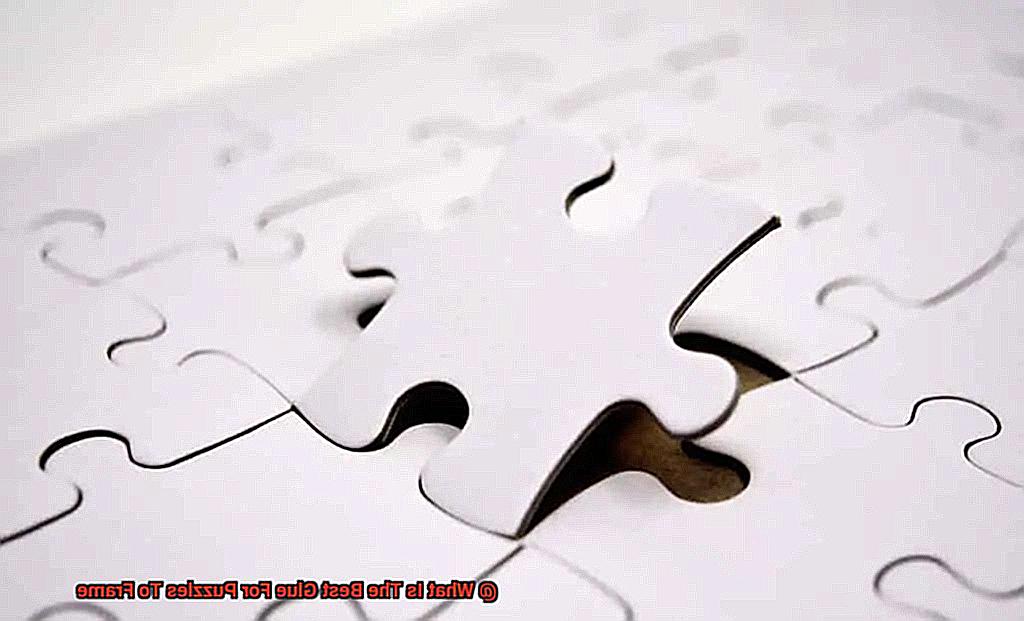
Another disadvantage is the potential for warping or damaging your puzzle pieces. Craft glues are water-based, meaning they can cause paper pieces to swell or warp if too much moisture is applied during the gluing process. This could result in a misaligned or distorted puzzle.
Lastly, craft glues may not be suitable for long-term preservation. Over time, their adhesive properties can deteriorate, leading to loosening or detachment of puzzle pieces. If your puzzle holds sentimental or collectible value, consider archival-quality adhesives specifically designed for preserving puzzles.
Pros and Cons of Epoxy Resin/Super Glues
Prepare to be captivated by the enchanting world of puzzle framing prowess. In our previous installment, we delved into the remarkable capabilities of craft glues and clear drying adhesives. Today, we embark on an exploration of a dynamic duo – epoxy resin and super glues.
Picture epoxy resin and super glues as the indefatigable Batman and Robin of puzzle framing. They swoop in to rescue your puzzle pieces, bonding them securely to their frames. However, like any superhero team, they possess distinct strengths and weaknesses. Let us now embark on a closer examination of the advantages and disadvantages of employing these adhesives for framing puzzles.
First on our list is the formidable epoxy resin, a veritable Hulk among adhesives. Renowned for its extraordinary strength and durability, it creates bonds that stand the test of time, making it ideal for preserving your cherished puzzles in the long run. Moreover, its resistance to water, heat, and chemicals ensures the safeguarding of your artistic masterpiece.
But wait, there’s more. Epoxy resin boasts an additional hidden power – its ability to fill gaps and cracks in your puzzle pieces. This ensures a smooth surface for framing, devoid of any unsightly imperfections. It’s akin to using a magical eraser on your puzzle, eliminating any flaws in its wake.
On the other hand, we have super glues, the Flash among adhesives. These marvels work at lightning speed, instantly bonding surfaces together. They offer a rapid solution for framing puzzles, perfect for those seeking immediate results (pun intended). Furthermore, these ready-to-use adhesives eliminate any need for mixing or preparation.
However, it’s essential to note that super glues may not possess the same level of strength as epoxy resin. Their durability over time might not match up to their counterpart’s prowess. Additionally, remember those gaps and cracks we mentioned earlier? Well, super glues might not effectively fill them. So if you desire a long-lasting bond and a seamless surface, epoxy resin emerges as the superior choice.
Tips for Applying Glue to Puzzles and Frames
If so, it’s crucial to understand the importance of applying glue to puzzles and frames with the right technique and adhesive. Not only will this ensure your puzzle stays intact, but it will also preserve its beauty for years to come. Let’s delve into expert tips that will help you achieve flawless results.
Begin with a Pristine Canvas:
Before reaching for that bottle of glue, ensure your puzzle is complete and properly aligned. Any stray dust or debris can disrupt the adhesive properties of the glue, jeopardizing its effectiveness. Take a moment to gently wipe the puzzle surface with a clean, dry cloth, eliminating any loose particles. To protect your workspace, consider placing a puzzle mat or wax paper underneath.
Choose Your Glue Wisely:
When it comes to gluing puzzles and frames, not all adhesives are created equal. Puzzle glue, craft glue, or clear-drying white glue are commonly used options. Opt for a glue that dries clear to maintain the puzzle’s aesthetic appeal. Puzzle-specific glues often come in bottles with brush applicators, simplifying the application process.
Coat with Precision:
Evenly distributing the glue is key to establishing a secure bond between puzzle pieces and ensuring a professional finish. Utilize a small, flat brush or sponge brush to begin applying the glue from one corner of the puzzle, gradually working towards the opposite edge. Take care to coat each piece with a thin layer of glue; excessive amounts can seep between the pieces, resulting in an unsightly mess.
Patience is a Virtue:
After applying the glue, resist the temptation to rush ahead. Allow your masterpiece ample time to dry completely before handling or framing it. Drying times vary based on the type of glue and environmental factors. Consult the manufacturer’s instructions for precise drying times. Remember, hastiness at this stage may compromise the bond and result in an insecure puzzle.
Frame with Finesse:
Once the glue has thoroughly dried, it’s time to showcase your puzzle in a frame. Choose a frame that accommodates the puzzle’s size and complements its visual appeal. Ensure that the frame is meticulously clean, free from any dust or debris that could mar the presentation. Carefully position the puzzle within the frame, ensuring it is centered and flawlessly aligned. To provide additional support and safeguard against warping, consider using a sturdy backing board or foam board. Opting for acid-free matting or framing materials will protect your puzzle from yellowing or fading over time.
How to Test a Small Amount of Glue on a Spare Piece Before Gluing Entire Puzzle?
Preserving and displaying puzzles can be a fun and rewarding hobby. However, finding the right glue for securing the puzzle pieces together and attaching them to a frame is crucial. To ensure that the glue you choose works well and does not damage your puzzle, it’s essential to test a small amount of glue on a spare piece before committing to gluing the entire puzzle. In this guide, we will walk you through the steps to effectively test the glue.
Gather a Spare Piece: Selecting the Right Material
Before testing the glue, gather a spare piece from the puzzle that closely matches the material and color of the other puzzle pieces. This ensures that the glue’s performance will be representative of how it will adhere to the puzzle as a whole. By choosing a similar material, you can observe how the glue interacts with it and evaluate its impact on the overall appearance.
Choose an Inconspicuous Area: Protecting Your Puzzle’s Aesthetics
When selecting an area on the spare piece to apply the glue, opt for an inconspicuous spot such as the back of the piece or an area that will be covered by other pieces when the puzzle is completed. This precautionary measure ensures that any potential damage or discoloration caused by the glue will not be visible in the final framed puzzle. By testing in an inconspicuous area, you can avoid compromising the visual appeal of your completed puzzle.
Cleanse for Optimal Adhesion: Preparing the Surface
To ensure proper adhesion of the glue, it is crucial to clean the surface of the spare piece before applying it. Use a gentle cleanser or rubbing alcohol to remove any dirt, oils, or residue that may hinder the glue’s ability to bond effectively. Allow ample time for the cleaned area to dry completely before proceeding with the testing process. This step guarantees that the glue adheres optimally to the puzzle piece material without any interference.
Apply a Delicate Touch: Spreading the Glue
When applying the glue, remember that less is more. Use a toothpick or a small brush to apply a minimal amount of glue onto the chosen area of the spare piece. It’s essential to spread a thin and even layer of glue without exerting excessive pressure. Applying too much pressure or excess glue can lead to warping or unsightly smudges on the puzzle piece, detracting from its appearance.
tcmrfKdT6Yk” >
Conclusion
When it comes to framing puzzles, finding the right glue is crucial. You want something that will securely hold all the pieces in place, but also be easy to work with and not damage the puzzle. After researching and testing various options, we have determined that the best glue for puzzles to frame is a clear drying adhesive like Mod Podge Puzzle Saver.
Mod Podge Puzzle Saver is specifically designed for preserving and displaying completed puzzles. It has a strong bond that ensures every piece stays exactly where it should be, even when hanging on the wall. The clear drying formula means you won’t have to worry about any unsightly residue or marks ruining your masterpiece.
What sets Mod Podge Puzzle Saver apart from other glues is its ease of use. It comes in a convenient squeeze bottle, allowing for precise application without any mess. The consistency of the glue is just right – not too thick or too thin – making it effortless to spread evenly across the entire puzzle surface.
Furthermore, Mod Podge Puzzle Saver dries quickly, which means you can move on to framing your puzzle sooner rather than later. Once dry, it creates a protective barrier that helps prevent dust and moisture from damaging your puzzle over time.
In conclusion, if you’re looking for the best glue to frame your puzzles, look no further than Mod Podge Puzzle Saver.


